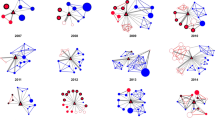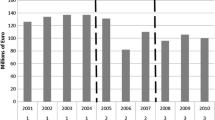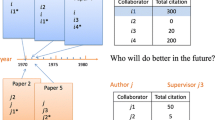Abstract
In this paper we consider the question what is the scientific and career performance of principal investigators (PI’s) of publicly funded research projects compared to scientific performance of all researchers. Our study is based on high quality data about (1) research projects awarded in Slovenia in the period 1994–2016 (7508 projects with 2725 PI’s in total) and (2) about scientific productivity of all researchers in Slovenia that were active in the period 1970–2016—there are 19,598 such researchers in total, including the PI’s. We compare average productivity, collaboration, internationality and interdisciplinarity of PI’s and of all active researchers. Our analysis shows that for all four indicators the average performance of PI’s is much higher compared to average performance of all active researchers. Additionally, we analyze careers of both groups of researchers. The results show that the PI’s have on average longer and more fruitful career compared to all active researchers, with regards to all career indicators. The PI’s that have received a postdoc grant have at the beginning outstanding scientific performance, but later deviate towards average. On long run, the PI’s leading the research programs (the most prestigious grants) on average demonstrate the best scientific performance. In the last part of the paper we study 23 co-authorship networks, spanned by all active researchers in the periods 1970–1994, ..., 1970–2016. We find out that they are well connected and that PI’s are well distributed across these networks forming their backbones. Even more, PI’s generate new PI’s, since more than 90% of new PI’s are connected (have at least one joint scientific publication) with existing PI’s. We believe that our study sheds new light to the relations between the public funding of the science and the scientific output and can be considered as an affirmative answer to the question posed in the title.


















Similar content being viewed by others
Notes
We say that a publication is scientific if it is classified as an original scientific article, a review article, a short scientific article, a published scientific conference contribution, a published scientific conference contribution abstract, an independent scientific component or a chapter in a monograph, or a scientific monograph.
We do this, since there are several researchers which published a scientific publication long before they obtained their PhD, and after PhD they also obtained a postdoctoral project, resulting in statistically irrelevant long tails in the career path analyses. We take 7 years as a sum of 4 years of doctoral studies and three year period to obtain the project.
Such a big difference surprised us, so we computed these averages also for both groups after ignoring (1) the researchers that have stopped within 3 years after the first publication (they probably had left academia after PhD, so are not typical members of the research community) and (2) the researchers that are still active, since we do not know when they will stop (we kept only those who haven’t publish anything in the years 2015–2016; they probably had stopped their publication career already). However, the gap remains almost the same (the average for PI’s was 26.4 and the average for all active researchers was 15.3).
References
Baglieri, D., & Lorenzoni, G. (2014). Closing the distance between academia and market: Experimentation and user entrepreneurial processes. The Journal of Technology Transfer, 39(1), 52–74.
Ball, S. (2007). Leadership of academics in research. Educational Management Administration & Leadership, 35(4), 449–477.
Bland, C. J., & Ruffin, M. T. (1992). Characteristics of a productive research environment: Literature review. Academic Medicine, 67(6), 385–97.
Boardman, C., & Ponomariov, B. (2014). Management knowledge and the organization of team science in university research centers. The Journal of Technology Transfer, 39(1), 75–92.
Boardman, P. C., & Corley, E. A. (2008). University research centers and the composition of research collaborations. Research Policy, 37(5), 900–913.
Bushaway, R. (2003). Managing research. Philadelphia, PA: Open University Press.
Casati, A., & Genet, C. (2014). Principal investigators as scientific entrepreneurs. The Journal of Technology Transfer, 39(1), 11–32.
Çavuşoğlu, A., & Türker, I. (2013). Scientific collaboration network of turkey. Chaos, Solitons & Fractals, 57, 9–18.
Cunningham, J. A., Mangematin, V., O’Kane, C., & O’Reilly, P. (2016a). At the frontiers of scientific advancement: The factors that influence scientists to become or choose to become publicly funded principal investigators. The Journal of Technology Transfer, 41(4), 778–797.
Cunningham, J. A., Menter, M., & O’Kane, C. (2018). Value creation in the quadruple helix: A micro level conceptual model of principal investigators as value creators. R&D Management, 48(1), 136–147.
Cunningham, J., O’Reilly, P., O’Kane, C., & Mangematin, V. (2014). The inhibiting factors that principal investigators experience in leading publicly funded research. The Journal of Technology Transfer, 39(1), 93–110.
Cunningham, J. A., O’Reilly, P., O’Kane, C., & Mangematin, V. (2015). Managerial challenges of publicly funded principal investigators. International Journal of Technology Management, 68(3–4), 176–202.
Cunningham, J. A., O’Reilly, P., O’Kane, C., & Mangematin, V. (2016b). Publicly funded principal investigators as transformative agents of public sector entrepreneurship. In D. B. Audretsch & A. N. Link (Eds.), Essays in public sector entrepreneurship (pp. 67–94). Cham: Springer. https://doi.org/10.1007/978-3-319-26677-0.
Del Giudice, M., Nicotra, M., Romano, M., & Schillaci, C. E. (2017). Entrepreneurial performance of principal investigators and country culture: Relations and influences. The Journal of Technology Transfer, 42(2), 320–337.
Feeney, M. K., & Welch, E. W. (2014). Academic outcomes among principal investigators, co-principal investigators, and non-pi researchers. The Journal of Technology Transfer, 39(1), 111–133.
Ferligoj, A., & Kronegger, L. (2009). Clustering of attribute and/or relational data. Metodoloski zvezki, 6(2), 135–153.
Ferligoj, A., Kronegger, L., Mali, F., Snijders, T. A., & Doreian, P. (2015). Scientific collaboration dynamics in a national scientific system. Scientometrics, 104(3), 985–1012.
Glänzel, W. (2001). National characteristics in international scientific co-authorship relations. Scientometrics, 51(1), 69–115.
Glänzel, W., & Schubert, A. (2005). Domesticity and internationality in co-authorship, references and citations. Scientometrics, 65(3), 323–342.
Han, P., Shi, J., Li, X., Wang, D., Shen, S., & Su, X. (2014). International collaboration in lis: Global trends and networks at the country and institution level. Scientometrics, 98(1), 53–72.
Hâncean, M. G., & Perc, M. (2016). Homophily in coauthorship networks of east european sociologists. Scientific Reports, 6, 36152.
Hemlin, S. (2006). Creative knowledge environments for research groups in biotechnology. The influence of leadership and organizational support in universities and business companies. Scientometrics, 67(1), 121–142.
Jain, S., George, G., & Maltarich, M. (2009). Academics or entrepreneurs? Investigating role identity modification of university scientists involved in commercialization activity. Research Policy, 38(6), 922–935.
Karlovčec, M., & Mladenić, D. (2015). Interdisciplinarity of scientific fields and its evolution based on graph of project collaboration and co-authoring. Scientometrics, 102(1), 433–454.
Karlovčec, M., Lužar, B., & Mladenić, D. (2016). Core-periphery dynamics in collaboration networks: The case study of Slovenia. Scientometrics, 109, 1561–1578.
Kastrin, A., Klisara, J., Lužar, B., & Povh, J. (2017). Analysis of Slovenian research community through bibliographic networks. Scientometrics, 110, 791–813.
Katz, J. S., & Martin, B. R. (1997). What is research collaboration? Research Policy, 26(1), 1–18.
Kidwell, D. K. (2014). Navigating the role of the principal investigator: A comparison of four cases. The Journal of Technology Transfer, 39(1), 33–51.
Kim, J., Tao, L., Lee, S. H., & Diesner, J. (2016). Evolution and structure of scientific co-publishing network in Korea between 1948–2011. Scientometrics, 107(1), 27–41.
Kronegger, L., Mali, F., Ferligoj, A., & Doreian, P. (2012). Collaboration structures in slovenian scientific communities. Scientometrics, 90(2), 631–647.
Kronegger, L., Mali, F., Ferligoj, A., & Doreian, P. (2015). Classifying scientific disciplines in slovenia: A study of the evolution of collaboration structures. Journal of the Association for Information Science and Technology, 66(2), 321–339.
Kwiek, M. (2015). Academic generations and academic work: Patterns of attitudes, behaviors, and research productivity of polish academics after 1989. Studies in Higher Education, 40(8), 1354–1376.
Lane, J. (2010). Let’s make science metrics more scientific. Nature, 464(7288), 488–489.
Lee, S., & Bozeman, B. (2005). The impact of research collaboration on scientific productivity. Social Studies of Science, 35(5), 673–702.
Leydesdorff, L., & Etzkowitz, H. (1996). Emergence of a triple helix of universityindustrygovernment relations. Science and Public Policy, 23(5), 279–286.
Lotka, A. J. (1926). The frequency distribution of scientific productivity. Journal of the Washington Academy of Sciences, 16(12), 317–323.
Lužar, B., Levnajić, Z., Povh, J., & Perc, M. (2014). Community structure and the evolution of interdisciplinarity in Slovenia’s scientific collaboration network. PLoS ONE, 9(4), e94429.
Mangematin, V., O’Reilly, P., & Cunningham, J. (2014). PIs as boundary spanners, science and market shapers. The Journal of Technology Transfer, 39(1), 1–10.
Melkers, J., & Xiao, F. (2012). Boundary-spanning in emerging technology research: Determinants of funding success for academic scientists. The Journal of Technology Transfer, 37(3), 251–270.
Mena-Chalco, J. P., Digiampietri, L. A., Lopes, F. M., & Cesar, R. M. (2014). Brazilian bibliometric coauthorship networks. Journal of the Association for Information Science and Technology, 65(7), 1424–1445.
Menter, M. (2016). Principal investigators and the commercialization of knowledge. In D. Audretsch, E. Lehmann, M. Meoli, & S. Vismara (Eds.), University evolution, entrepreneurial activity and regional competitiveness (pp. 193–203). Cham: Springer. https://doi.org/10.1007/978-3-319-17713-7.
Miller, K., Alexander, A., Cunningham, J. A., & Albats, E. (2018). Entrepreneurial academics and academic entrepreneurs: A systematic literature review. International Journal of Technology Management, 77(1–3), 9–37.
Moses, I. (1985). The role of head of department in the pursuit of excellence. Higher Education, 14(4), 337–354.
O’Kane, C., Cunningham, J., Mangematin, V., & O’Reilly, P. (2015). Underpinning strategic behaviours and posture of principal investigators in transition/uncertain environments. Long Range Planning, 48(3), 200–214.
O’Kane, C., Zhang, J. A., Cunningham, J. A., & OReilly, P. (2017). What factors inhibit publicly funded principal investigators commercialization activities? Small Enterprise Research, 24(3), 215–232.
O’Reilly, P., & Cunningham, J. A. (2017). Enablers and barriers to university technology transfer engagements with small-and medium-sized enterprises: Perspectives of principal investigators. Small Enterprise Research, 24(3), 274–289.
Perc, M. (2010a). Growth and structure of Slovenia’s scientific collaboration network. Journal of Informetrics, 4(4), 475–482.
Perc, M. (2010b). Zipf’s law and log-normal distributions in measures of scientific output across fields and institutions: 40 years of Slovenia’s research as an example. Journal of Informetrics, 4(3), 358–364.
Pravdić, N., & Oluić-Vuković, V. (1986). Dual approach to multiple authorship in the study of collaboration/scientific output relationship. Scientometrics, 10(5–6), 259–280.
Uzzi, B., Mukherjee, S., Stringer, M., & Jones, B. (2013). Atypical combinations and scientific impact. Science, 342(6157), 468–472.
Van Rijnsoever, F. J., & Hessels, L. K. (2011). Factors associated with disciplinary and interdisciplinary research collaboration. Research Policy, 40(3), 463–472.
Yang, L., & Webber, K. L. (2015). A decade beyond the doctorate: The influence of a us postdoctoral appointment on faculty career, productivity, and salary. Higher Education, 70(4), 667–687.
Acknowledgements
This research was partially supported by Slovenian Research Agency Program P1-0383 and Projects J1-8155, N1-0057.
Author information
Authors and Affiliations
Corresponding author
Rights and permissions
About this article
Cite this article
Kastrin, A., Klisara, J., Lužar, B. et al. Is science driven by principal investigators?. Scientometrics 117, 1157–1182 (2018). https://doi.org/10.1007/s11192-018-2900-x
Received:
Published:
Issue Date:
DOI: https://doi.org/10.1007/s11192-018-2900-x




